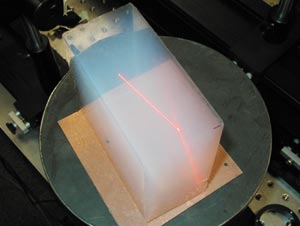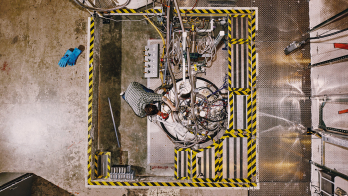
Particle identification is a fundamental requirement for experiments such as LHCb that are dedicated to the study of B physics. Meaningful CP violation measurements will be possible only if hadron identification is available to reconstruct specific final states with high purity, and to tag the flavour of the b-hadron with high efficiency for the many B decay modes that can exhibit CP violating asymmetries. Now a team working in Novosibirsk, Russia, is successfully making highly transparent aerogel for the LHCb RICH (Rich Imaging Cerenkov) detector, which will play a key role in particle identification.
An important optical requirement of a Cerenkov radiator is not to scatter the produced photons. Any angular dispersion caused by the radiator medium will reduce the precision on the Cerenkov emission angle. In the momentum region of 2-10 GeV/c, an aerogel radiator having an index of refraction around n = 1.030 provides a good solution. Aerogel is a very-low-density material (0.1 g/cm3), essentially made of SiO2, and the dominant cause of image degradation is due to Rayleigh scattering.
The feasibility of a RICH detector with aerogel as a Cerenkov light radiator was demonstrated only a few years ago, in 1997, and relies on the excellent quality of aerogel available today. Aerogel produced by the Matsushita company in Japan is currently used in the RICH detector in the HERMES experiment at DESY.
The typical transverse dimensions of aerogel tiles are 10 x 10 cm2, and the typical thickness is 1 or 2 cm. It is technically very difficult to increase the thickness while maintaining the optical quality with the level of clarity needed. However, in order to achieve the required performance, the LHCb RICH detector needs a highly transparent aerogel radiator with a thickness of 4-6 cm.
The aerogel block shown in the picture has been produced in Novosibirsk by a collaboration of the Boreskov Institute of Catalysis and the Budker Institute of Nuclear Physics, with support from a CERN-INTAS grant. It has dimensions of 10 x 10 x 5.5 cm3 and a refractive index of 1.03. Its effective scattering length for Cerenkov light at a wavelength of 400 nm is 43 mm, only 15% less than for the best thin aerogel samples.







